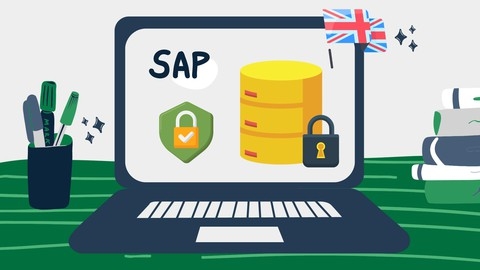SAP security is a critical aspect of ensuring the integrity and confidentiality of your organization’s data and systems.
It involves managing user access, implementing security policies, and protecting sensitive information from unauthorized access and threats.
Mastering SAP security can empower you to build a robust and secure environment for your business operations, protecting valuable assets and ensuring compliance with regulations.
Finding the right SAP security course on Udemy can be a daunting task.
With so many options available, it’s easy to feel overwhelmed and unsure where to start.
You’re looking for a course that provides a comprehensive understanding of SAP security principles, practical skills for managing users and roles, and hands-on experience with security tools.
For the best SAP security course overall on Udemy, we recommend SAP Security Administration.
This course stands out for its comprehensive coverage of SAP security fundamentals, practical applications, and security best practices.
It dives deep into authorization concepts, user management, and security tools like the SAP Audit Information System (AIS) and CCMS Alert Monitor, preparing you to confidently secure your SAP environment.
This is just one of many great SAP security courses available on Udemy.
Keep reading to discover our recommendations for different learning levels and areas of specialization, including courses focused on SAP HANA security, Fiori security, and technical security aspects of SAP systems.
SAP Security Administration
You’ll start by building a strong foundation in the fundamentals of SAP authorization – the rules that govern user access.
This includes understanding core concepts like authorization objects, profiles, and roles, which are essential for effective security management.
The course then takes you into practical applications, showing you how to create and manage users within the SAP system, maintain roles and profiles using tools like the PFCG Profile Generator, and even design and develop your own authorization concepts.
You’ll also explore advanced topics like authorization development, allowing you to create custom authorization objects tailored to your unique business needs.
Beyond the basics, the course emphasizes security best practices.
You’ll learn how to conduct security audits, analyze authorization issues, and implement segregation of duty (SoD) to prevent unauthorized access and fraud.
The course also introduces you to powerful security tools like the SAP Audit Information System (AIS) and CCMS Alert Monitor, which you can use to monitor system activities and identify potential security threats.
You’ll also delve into securing your SAP systems from a network perspective, gaining a clear understanding of Secure Network Communications (SNC) and how to implement it effectively.
The course also covers the specific security needs of SAP HCM, including concepts like HR authorization, structural authorizations, indirect role assignments, and transporting authorizations.
This ensures you have a holistic understanding of securing your SAP environment, covering everything from user accounts and passwords to production systems and network communications.
SAP Security Training for all
You’ll delve into the core concepts of SAP security, understanding the SAP Landscape, the Client concept, and the critical role of security entities like role approvers and critical action permissions.
This foundational knowledge will empower you to confidently implement and manage these essential security elements.
The course then moves into the practical aspects of SAP security, covering critical areas like user management, role administration, and password policy management.
You’ll learn the nuances of different user types and master the art of user administration, including efficient mass user management with SU10.
You’ll gain hands-on experience with powerful tools like SU24 and RZ10, enabling you to confidently maintain your SAP environment and efficiently implement critical changes.
Beyond individual user management, you’ll explore the importance of Central User Administration (CUA) and learn how to effectively manage composite and derived roles.
You’ll discover how to implement best practices for SAP security, including the SAP Baseline process, and develop a structured approach to troubleshoot security issues, utilizing techniques like user trace.
The course also covers the critical aspects of managing security during upgrades and leveraging the powerful SUIM reporting tool to ensure ongoing security and compliance.
This course will provide you with the skills and confidence to implement and manage a robust SAP security strategy, safeguarding your organization’s valuable data and systems.
SAP Security: A Deep Dive into Roles and Authorizations
You’ll delve into the core concepts, mastering how to manage users, assign roles effectively, and troubleshoot authorization issues with precision.
The course equips you with practical skills by immersing you in the use of powerful tools like SUIM.
This user information system empowers you to locate users and roles based on specific criteria, streamlining your security management tasks.
You’ll also gain proficiency in using SU53, a critical tool for diagnosing authorization errors and understanding the root cause of user access issues.
Beyond these fundamental tools, you’ll learn how to trace user activities, a skill invaluable for detecting potential security breaches and ensuring the integrity of your SAP environment.
With this knowledge, you’ll be well-equipped to confidently navigate and analyze SAP security, safeguarding sensitive data from unauthorized access.
A Beginner’s guide to SAP HR Security
This course takes a structured approach, starting with the fundamentals of the HR system and its data structure.
Beyond the basics, the course dives into critical concepts like role assignment.
You’ll learn how to manage user access effectively by understanding both indirect role assignment based on communication details and direct role assignment based on an employee’s position or organizational unit.
One of the course’s strengths is its focus on structural authorizations – a powerful tool for restricting access based on organizational structures.
You’ll explore the concept, its implementation, and its importance in securing sensitive data.
The course also delves into PD profiles, a key element of authorization management.
You’ll learn how to assign these profiles directly and indirectly, understanding the nuances of each method.
Finally, you’ll gain a deep understanding of authorization objects related to PA data (personnel administration) and OM data (organizational management), along with clusters of objects.
This course will equip you with the knowledge and skills to confidently secure your SAP HR system, ensuring data integrity and compliance.
SAP Fiori Security - 2024
The course starts by introducing you to Fiori and giving an overview.
You’ll learn about the history of SAP Fiori and what it is, with a demo of the Fiori Launchpad (FLP).
The course covers the Fiori Apps Library and deployment options like Gateway vs Embedded.
You’ll find out how to locate Fiori configuration details.
An important part is understanding the different Fiori end user and admin roles for embedded and gateway configurations.
The course dives into Fiori application security and the authorization flow.
You’ll go through a practical example of a Fiori app to really understand the UI layer, tiles, TM, apps, and catalogs from both technical and business perspectives.
You’ll learn how to create a custom catalog by copying a standard SAP catalog and using the Launchpad Designer tool.
The course covers pages and spaces in depth.
It also provides guidance on troubleshooting, miscellaneous topics, and useful Fiori transactions.
Finally, you’ll learn about the different scopes in Fiori.
The practical examples and focus on roles should help you gain hands-on understanding.
SAP Technical Security
This course provides a comprehensive deep dive into the technical security aspects of SAP systems.
You’ll start by exploring the critical role of passwords, learning to identify and rectify weak password hashes through hands-on exercises using tools like HashCat.
You’ll gain a thorough understanding of various password hashing techniques and learn how to implement best practices for password security.
Next, you’ll delve into the intricacies of the Remote Function Call (RFC) protocol, including its architecture and security considerations.
You’ll discover how to secure RFC communications by analyzing the RFC Gateway architecture and utilizing the RFC SDK.
This module will equip you with the knowledge to implement robust security measures for RFC-based communication within your SAP environment.
The course continues by exploring the importance of security logs in SAP, focusing on the SAP Security Audit Log (SAL) and its role in monitoring system activity.
You’ll learn how to utilize SAL effectively to detect and analyze security incidents.
You’ll also gain valuable knowledge of table change logging and how to implement it to track modifications in your SAP database, ensuring data integrity and accountability.
Moving on, you’ll explore the WebDispatcher and its architecture, gaining the skills to confidently administer WebDispatcher using the Web Administration Interface.
You’ll learn best practices for securing public pages within your SAP system and understand how to manage access control for sensitive areas.
The course also dives deep into the intricacies of user management, equipping you with the knowledge to implement robust user management policies within your SAP environment.
You’ll become proficient in SAP GUI scripting and security best practices, enabling you to secure and manage your SAP GUI applications effectively.
Finally, you’ll explore the security aspects of Remote Enabled Function Modules (RFMs) and User Connection (UCON), essential components for secure remote communication within SAP.
You’ll gain a solid grasp of the UCON implementation in RFC scenarios and learn how to manage authorizations for RFMs, ensuring secure access to sensitive data and processes.
This course concludes with a discussion on the security aspects of Process Orchestration, covering encryption techniques on both the server and client sides.
You’ll leave with a thorough understanding of how to protect sensitive data during processing and data transfers, ensuring the security of your SAP processes.
This comprehensive training will equip you with a thorough understanding of SAP security best practices, enabling you to safeguard your SAP systems against potential threats and build a secure and robust SAP environment.






